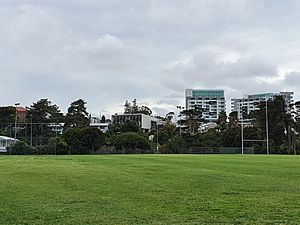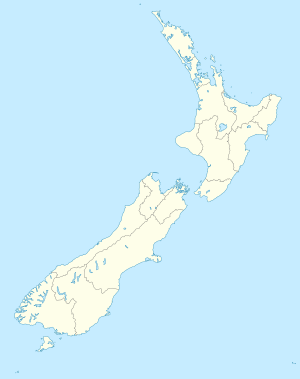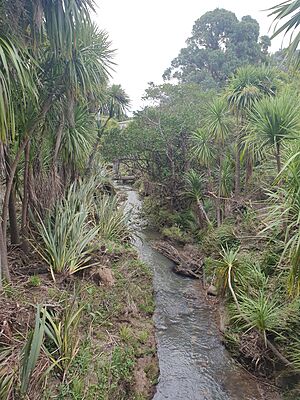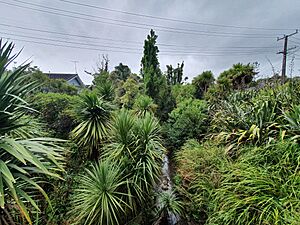Glen Eden, New Zealand facts for kids
Quick facts for kids
Glen Eden
|
|
|---|---|
|
Suburb
|
|

Glen Eden town centre, Playhouse Theatre and Glen Eden library seen from Harold Moody Park
|
|
| Country | New Zealand |
| Local authority | Auckland |
| Electoral ward | Waitākere ward |
| Local board | Waitākere Ranges Local Board |
| Area | |
| • Land | 753 ha (1,861 acre) |
| Population
(June 2023)
|
|
| • Total | 20,380 |
| Train station(s) | Glen Eden railway station |
|
|
||
Glen Eden is a suburb of West Auckland, New Zealand, located at the foothills of Waitākere Ranges. Originally known as Waikumete, the suburb gained the name Glen Eden in 1921. The suburb is in the Waitākere Ward, one of the thirteen administrative areas of Auckland governed by Auckland Council.
Originally part of the rohe of Te Kawerau ā Maki, the area developed into orchards during the Colonial era of New Zealand. The Glen Eden railway station opened in 1880, linking the area to central Auckland along the Western Line, and leading to the development of the Waikumete Cemetery. Suburban housing was built in the area in the 1950s and 1960s.
Contents
Geography
The Glen Eden area is located at the foothills of Waitākere Ranges, north of Titirangi. The Waikumete Stream flows north from Titirangi, forming a valley in the centre of the suburb. Glen Eden forms a part of the Waitematā-Waitākere foothills ecological zone. Sheltered from the Tasman Sea by the Waitākere Ranges, the area was traditionally dominated by forests of kauri, Phyllocladus trichomanoides (tānekaha or celery pine) and rimu, with abundant nīkau palm and silver fern. The soils are a mix of Miocene Waitākere volcanic soil and Waitemata Group sedimentary rock.
History
The area is within the traditional rohe of Te Kawerau ā Maki, an iwi that traces their ancestry to some of the earliest inhabitants of the Auckland Region. West Auckland was known as Hikurangi, and the area of the upper catchments of Te Wai-o-Pareira / Henderson Creek was known as Ōkaurirahi, a reference to the mature kauri forests of the area. The northern Glen Eden and Kelston area was called Onewherowhero, a reference to the red coloured clay found in the area. Te Kawerau ā Maki had a kāinga near modern Holdens Road in Oratia, close to Glen Eden. In 1825, most members of Te Kawerau ā Maki fled the area for refuge in the Waikato during the Musket Wars, with a small number remaining in the area to maintain ahi kā (fires of continuous occupation). After the Musket Wars, Te Kawerau ā Maki returned to the area in the 1830s. Most members chose to settle close to a defensive pā at Te Henga / Bethells Beach.
After the 1840 signing of the Treaty of Waitangi, paramount chief Apihai Te Kawau of the iwi now known as Ngāti Whātua Ōrākei made a tuku (strategic gift) of land at Waihorotiu on the Waitematā Harbour, which developed into the modern city of Auckland. By this time, modern Glen Eden was known as Waikomiti or Waikumete, literally meaning "Water of the Wooden Bowl", referring to a type of snare used to catch kererū. Waikūmete is a traditional Te Kawerau ā Maki name for Little Muddy Creek in south Titirangi on the Manukau Harbour, that was applied to the greater area during the time of European settlement. By the 1880s, the spelling Waikomiti was regularly described as a misspelling of Waikumete, and in 1898 the post office was officially renamed.
Early settlers such as John Bishop and Thomas Canty felled bush in the Oratia and Glen Eden areas from the mid-1840s. Kauri logging of the Waitākere Ranges foothills was an early industry which drew people to the area. Glen Eden was a part of the Titirangi Block sold to the crown in 1848. Permanent European settlers first arrived in the Glen Eden area in 1853, clearing the land to be used as orchards. The orchards began to prosper in the early 1900s, when immigrants from Dalmatia (modern-day Croatia) settled in the area. The clay soils made travelling in the area difficult, but were conductive for brickmaking, such as at Ceramco Park.
The Western Line opened in March 1880, connecting Waikumete to Auckland by rail and encouraging growth in the area. The train station acted as a hub for the community, with most businesses opening close to the station. In 1886, the Waikumete Cemetery was established, due to the proximity of the area to the Western Line. Many people viewed the cemetery as having a negative effect on the area, making it a less desirable place to live.
In 1901, the first town hall was built in the area, and in 1910 the first Methodist Church was constructed in Waikumete. Social life of the area revolved around the town hall, which showed movies, held dances and political meetings. During World War I, the hall was used to train territorials for the army.
The Waikumete Cemetery became the burial place for many of the people who died during the 1918 influenza pandemic. While local residents were mostly unscathed, people who died in Auckland were transported en masse to Waikumete Cemetery.
On 1 November 1921, Waikumete was renamed Glen Eden, when the area was formed into a town district. One of the reasons why the name changed was that the name Waikumete had become closely associated with the cemetery. The new name referenced the central Auckland suburb of Mount Eden, as well as the many valleys (glens) in the suburb. After the area was formed into a town district, the area boomed as a working class neighbourhood. The Great Depression greatly affected Glen Eden, leaving many new houses vacant as potential occupants could not afford to buy or rent them.
In 1935, the Glen Eden town hall burnt down, and was rebuilt within the next two years. The town hall remained a community social hub, holding events, movie showings and theatre productions. The building is currently known as the Glen Eden Playhouse Theatre. Between 1945 and 1954, the Waitemata Obstetric Hospital run by Vera Ellis-Crowther operated from her land on Glengarry Road.
The area developed from a rural community in the 1940s into a satellite suburb of Auckland in the 1950s. In 1953 the population of the area had increased enough that the town district became the Glen Eden Borough. The borough status of Glen Eden brought prosperity, and allowed the local council to borrow funds to develop the area. Between 1951 and 1961, the population of Glen Eden tripled. In 1970, Glenmall, a local shopping precinct was opened to the south of the train station. The population grew to over 10,000 residents in the mid-1980s.
Many street names in Glen Eden are named after early residents, and after Antarctic explorers from the Terra Nova Expedition (1910-1913). Most housing is wooden, with a few old farmhouses, some 1930s art deco houses, and post-war bungalows and weatherboard houses. There is also more recent terrace housing.
Demographics
Glen Eden covers 7.53 km2 (2.91 sq mi) and had an estimated population of 20380 as of June 2023, with a population density of 2707 people per km2.
| Historical population | ||
|---|---|---|
| Year | Pop. | ±% p.a. |
| 2006 | 15,396 | — |
| 2013 | 17,853 | +2.14% |
| 2018 | 19,008 | +1.26% |
| 2023 | 19,593 | +0.61% |
| The 2006 population is for a smaller area of 5.67 km2. | ||
Glen Eden had a population of 19,593 in the 2023 New Zealand census, an increase of 585 people (3.1%) since the 2018 census, and an increase of 1,740 people (9.7%) since the 2013 census. There were 9,660 males, 9,849 females and 84 people of other genders in 6,582 dwellings. 3.6% of people identified as LGBTIQ+. The median age was 34.6 years (compared with 38.1 years nationally). There were 4,308 people (22.0%) aged under 15 years, 3,885 (19.8%) aged 15 to 29, 9,387 (47.9%) aged 30 to 64, and 2,016 (10.3%) aged 65 or older.
People could identify as more than one ethnicity. The results were 53.3% European (Pākehā); 15.6% Māori; 21.6% Pasifika; 25.1% Asian; 3.2% Middle Eastern, Latin American and African New Zealanders (MELAA); and 1.7% other, which includes people giving their ethnicity as "New Zealander". English was spoken by 93.6%, Māori language by 3.0%, Samoan by 5.7%, and other languages by 23.2%. No language could be spoken by 2.9% (e.g. too young to talk). New Zealand Sign Language was known by 0.7%. The percentage of people born overseas was 35.5, compared with 28.8% nationally.
Religious affiliations were 33.2% Christian, 6.7% Hindu, 3.4% Islam, 1.0% Māori religious beliefs, 1.6% Buddhist, 0.5% New Age, 0.1% Jewish, and 1.8% other religions. People who answered that they had no religion were 44.8%, and 7.0% of people did not answer the census question.
Of those at least 15 years old, 4,194 (27.4%) people had a bachelor's or higher degree, 7,170 (46.9%) had a post-high school certificate or diploma, and 3,921 (25.7%) people exclusively held high school qualifications. The median income was $44,600, compared with $41,500 nationally. 1,689 people (11.1%) earned over $100,000 compared to 12.1% nationally. The employment status of those at least 15 was that 8,457 (55.3%) people were employed full-time, 1,746 (11.4%) were part-time, and 582 (3.8%) were unemployed.
| Name | Area (km2) |
Population | Density (per km2) |
Dwellings | Median age | Median income |
|---|---|---|---|---|---|---|
| Glen Eden West | 1.15 | 3,774 | 3,282 | 1,152 | 33.6 years | $41,000 |
| Glen Eden Rosier | 1.24 | 3,456 | 2,787 | 1,104 | 34.7 years | $44,100 |
| Glen Eden North | 1.88 | 2,673 | 1,422 | 969 | 33.7 years | $41,900 |
| Glen Eden Woodglen | 0.92 | 3,231 | 3,512 | 1,092 | 34.0 years | $47,100 |
| Glen Eden Central | 1.25 | 3,612 | 2,890 | 1,329 | 35.7 years | $44,200 |
| Glen Eden Konini | 1.09 | 2,847 | 2,612 | 939 | 35.9 years | $50,800 |
| New Zealand | 38.1 years | $41,500 |
Landmarks and features
- Ceramco Park. The site of a former clay quarry and landfill, the park features the Ceramco Park Function Centre and Glen Eden Athletics and Harrier Club.
- Glen Eden Library, built in 2004.
- Glen Eden Playhouse Theatre. A theatre originally built as a town hall and cinema.
- Glen Eden railway station
- Glenmall, also known as the Glen Eden Village. The commercial centre of the suburb, situated on West Coast Road.
- Hoani Waititi Marae. Established as a pan-tribal marae for Urban Māori.
- Parrs Park. A large recreational park in the western Glen Eden/Oratia area.
- Waikumete Cemetery. The cemetery is the second largest cemetery in the Southern Hemisphere, and includes 43.9 hectares of protected urban forest and streams, including the largest remaining gumland forest of the Tāmaki Ecological District.
- Waikumete Stream. A stream that forms part of the catchment for Te Wai-o-Pareira / Henderson Creek. The stream begins in Titirangi, flows north then north-west through Glen Eden, and meets the Oratia Stream at Sunnyvale. The stream forms a part of Te Ara Hono, an Auckland Council path linking Glen Eden to Kaurilands, and runs adjacent to the Kaurilands Domain, Ceramco Park, Upper Waikumete Stream Walk and Cycleway, Harold Moody Reserve, Ceramco Park and Duck Park.
Education
In the early 20th century, school children travelled to local primary schools in New Lynn and Henderson. In 1915, the first school that opened in the area, the Glen Eden Primary School. Originally known as Waikumete School, the school changed its name to Glen Eden School in 1921, when the suburb was renamed. The first school building was previously used for the school at New Lynn (the current location of Kelston Girls' College), which was transported to Glen Eden after a new school building was built for the New Lynn school. Today, Glen Eden Primary School is a contributing primary (years 1–6) school with a roll of 276 students. Prospect School opened in 1958, and is a contributing primary (years 1–6) school with a roll of 281. Another contributing school in the area is Konini School which opened in 1976. Te Kura Kaupapa Māori o Hoani Waititi, a composite Māori-language immersion school (years 1–13) with a roll of 243. All these schools are coeducational. Rolls are as at February 2024.
Glen Eden Intermediate School was built in 1960. It is a school for years 7–8 with a roll of 489 students, and located to the south of Glen Eden, in the modern suburb of Kaurilands. Local secondary schools nearby are Kelston Boys' High School and Kelston Girls' College, which opened as a co-educational high school in 1954 before separating in 1963.
Sport and recreation
The Glenora Rugby League team plays at Glenora Park.
Glen Eden has one of the oldest Scouts clubs in the country, which has running since 1925.
Transportation
Glen Eden is accessible by West Coast Road, an arterial road that separates from Great North Road at Kelston and heads towards Waiatarua, a settlement in the Waitākere Ranges. Glen Eden is serviced by the Glen Eden railway station, located on the Western Line of Auckland's suburban rail network.









